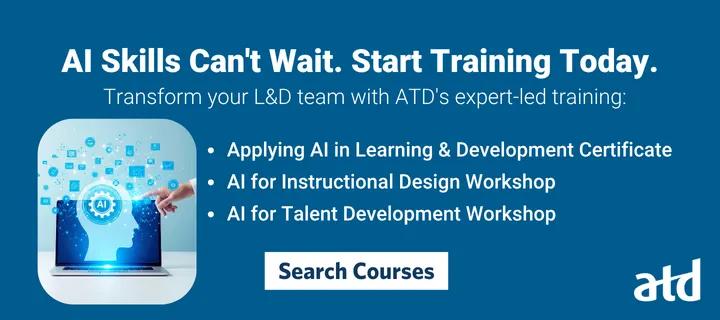ATD Blog
Navigating the Human Side of AI: A Guide to Stakeholder Collaboration
Let's explore critical questions and considerations for effective stakeholder collaboration throughout your AI project.
Mon Nov 18 2024

Artificial intelligence (AI) is rapidly transforming industries, but building a successful AI project takes more than innovative technology. It requires the invaluable input and collaboration of stakeholders. These stakeholders—including executives, end-users, technical teams, and legal and compliance experts—bring unique perspectives, priorities, and concerns. Their role is integral for ensuring alignment, securing buy-in, and delivering a successful AI solution.
This article explores critical questions and considerations for effective stakeholder collaboration throughout your AI project, including consulting best practices such as stakeholder analysis, communication planning, and risk management.
Define the Problem and Success Metrics
Before diving into solutions, resist immediately saying “yes.” Instead, thoroughly explore the problem with your stakeholders to understand their needs and expectations. Ask these critical questions:
What problem are we trying to solve? Why? Clearly explain the business challenge or opportunity that your AI project addresses. Is it to improve efficiency, enhance decision making, personalize customer experiences, or something else? Explain why this problem is important and how solving it will benefit the organization.
Example: “We’re facing low employee engagement with our current training programs, leading to knowledge gaps and skill deficiencies. This affects productivity and hinders career development. An AI-powered solution could personalize learning pathways, recommend relevant content, and provide timely feedback to improve engagement and knowledge retention.”
How will we know when we’ve solved it? Insist on measurements of success in advance. Define measurable success metrics. These could include increased accuracy, reduced costs, improved customer satisfaction, or faster processing times. Having clear metrics allows you to track progress, demonstrate the value of your AI solution, and manage expectations from the outset.
Example: “Success will be measured by increased course completion rates (by 20 percent), improved performance on knowledge assessments (average score increase of 10 percent), and higher employee satisfaction with training programs (measured through surveys).”
Leverage Existing Knowledge and Explore Alternatives
Do not reinvent the wheel. Tap into the collective knowledge of your stakeholders and be prepared to suggest alternatives:
What solutions have we tried already? Understanding past attempts, whether successful or not, provides valuable insights. What worked? What did not? Why? This knowledge helps you avoid repeating past mistakes and build upon previous efforts.
Example: “We’ve previously tried gamified learning modules but had limited success due to their lack of personalization and integration with existing learning platforms.”
What have you seen that works with this audience? Stakeholders often have valuable experience with the target audience or similar projects. Gather their insights on what approaches have resonated in the past and what factors might influence the adoption of your AI solution.
Example: “Employees have responded positively to microlearning modules and personalized feedback. Integrating these elements into the AI-powered learning platform could increase engagement.”
Scale down the solution to contain costs. If initial proposals exceed budget constraints, explore alternative solutions with a smaller scope or phased implementation.
Example: “Instead of a full-scale AI-powered learning platform, we could start with a pilot program focusing on a specific department or skill set.”
Address Ethical and Legal Considerations
AI projects raise ethical and legal questions.
What legal and ethical issues are most important? Depending on your project and industry, this could include data privacy, bias in algorithms, accountability for AI decisions, and potential job displacement. Engage legal and compliance experts early on to identify and mitigate potential risks. Transparency and explainability of your AI system are crucial for building stakeholder trust.
Example: “We need to ensure that the AI system does not perpetuate existing biases in training data and provides fair and equitable learning opportunities for all employees. Data privacy is also crucial, as the system will collect personal learning data.”
Manage Expectations and Resources
Setting realistic expectations and effectively managing resources are critical for project success.
Clearly defining the project scope, budget, and timeline is not just a formality but a way to manage expectations and ensure alignment. Communicating these constraints to stakeholders helps avoid unrealistic expectations and instills a sense of security and confidence in the project.
Which resources and team members are available? Identify the necessary skills and expertise for your AI project. This may include data scientists, software engineers, domain experts, and project managers. Ensure you have the right team, and their roles and responsibilities are clearly defined.
Ask for help and explain why you need it. Do not hesitate to request additional resources or support if needed. Clearly articulate the rationale for your request and how it will contribute to project success.
Example: “We must collaborate with the IT department to ensure seamless integration with existing systems and subject matter experts to curate relevant learning content. We may also need external AI specialists to support development.”
Foster Ongoing Communication and Collaboration
Effective communication is the cornerstone of successful stakeholder management.
Establishing regular and transparent communication channels is critical. This could include meetings, email updates, project dashboards, or collaborative platforms. Keeping stakeholders informed about progress, challenges, and decisions is not just a formality but a way to keep them involved and engaged.
Scheduling a follow-up meeting during the first one ensures continued engagement and allows you to address emerging questions or concerns.
Actively solicit feedback. Encourage stakeholders to provide input throughout the project lifecycle. This helps identify potential issues early on and fosters a sense of ownership and buy-in.
Example: “We’ll conduct regular demos of the AI-powered learning platform and gather feedback from employees and L&D professionals to ensure it meets their needs and expectations.”
Be responsive and transparent. Address stakeholder concerns promptly and honestly. Transparency about your AI system’s capabilities and limitations builds trust and manages expectations.
Embrace Change Management and Testing
Implementing an AI solution involves changes to existing workflows and processes. Effectively managing this change is crucial for successful adoption:
Communicate the benefits of the AI solution. Clearly explain how the AI system will improve efficiency, productivity, or decision making. Address any concerns about job displacement or changes in roles.
Example: “The AI-powered learning platform will free L&D professionals from administrative tasks, allowing them to focus on more strategic initiatives like curriculum design and mentorship.”
Provide adequate training and support. Equip users with the knowledge and skills to interact effectively with the AI system. Offer ongoing support to address any questions or challenges that arise.
Example: “We’ll provide comprehensive training to employees on how to use the new learning platform and offer ongoing support through online tutorials, FAQs, and help desk resources.”
Always include testing in the project plan. Thoroughly test the AI system before, during, and after implementation. This includes technical testing, user acceptance testing, and ongoing monitoring to ensure performance and identify areas for improvement.
Example: “We’ll conduct A/B testing to compare the effectiveness of AI-powered learning pathways with traditional approaches. We’ll also continuously monitor user engagement and feedback to improve the platform.”
Celebrate successes and recognize contributions. Acknowledge the efforts of your team and stakeholders in achieving project milestones. Celebrating successes reinforces the value of the AI solution and encourages continued engagement.
Want to learn more about leveraging AI in L&D?
This article is only a starting point for navigating stakeholder collaboration in AI projects. Consider attending the ATD AI for Talent Development Workshop to deepen your understanding and gain practical skills. This workshop is for talent managers and leaders who want to incorporate AI into their talent development workflows, practices, and coaching conversations.
By proactively addressing the questions and considerations outlined in this article, incorporating consulting best practices, and fostering a collaborative environment, you can effectively navigate the human side of AI and increase the likelihood of project success. Remember, building AI solutions is not just about the technology but about harnessing your stakeholders’ collective intelligence and expertise to create something truly transformative.

